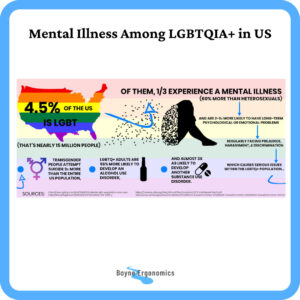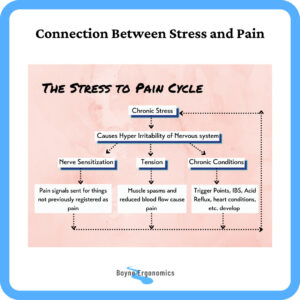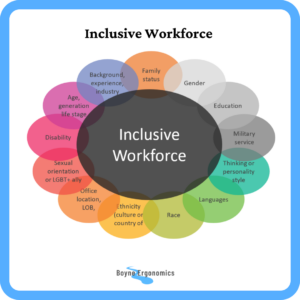June is recognised as LGBTQIA+ Pride month in many countries and the aim is to promote and celebrate dignity, equality and visibility of the LGBTQIA+ community.
In terms of the workplace, the LGBTQIA+ community are considered, along with women and migrant workers, to be at a higher risk of work-related musculoskeletal injury when compared to other groups.
In 2020, the European Agency for Safety and Health at Work, EU-OSHA, published a review of musculoskeletal disorders among female, migrant and LGBTQIA+ workers. This report detailed the physical, psychosocial, organisational and individual risk factors that may contribute to the prevalence of musculoskeletal disorders among these 3 groups.
In this blog post, I will be focusing on the risks identified by EU-OSHA for LGBTQIA+ workers across all working sectors within Europe. I will summarise the findings of this review but I do recommend that if you are an employer or are responsible for employee welfare, you should download this report and read through it, it makes for very interesting reading and can help pinpoint potential areas of harm for marginalised groups in the workplace. The name and link to the reports are at the end of the post.
It should be noted that, as per EU-OSHA, there is no direct evidence that LGBTQIA+ workers experience increased rates of musculoskeletal injury. However, there is evidence regarding the prevalence of the psychosocial risks factors below that can negatively impact LGBTQIA+ occupational health, and therefore they are likely to result in musculoskeletal disorders.
There may be a number of reasons for this lack of clear and direct evidence. It has been concluded that this may be due to a lack of recording of sexual and gender identity when carrying out studies on occupational and health and safety issues. Secondly, not all LGBTQIA+ workers feel comfortable being visible in the workplace, making it sometimes difficult to reach out to and access this group to record the prevalence of musculoskeletal disorders.
Prevalence of Health Issues and Musculoskeletal Disorders Among LGBTQIA+ Workers
While the recorded percentages vary withing the LGBTQIA+ subgroups, the overall findings have been that LGBTQIA+ workers experience reduced wellbeing and mental health compared to the general population. This includes increased reporting of suicidal thoughts, anxiety, depression and mental distress. There is also evidence that LGBTQIA+ workers report worse physical health, including musculoskeletal issues, arthritis, spinal issues and chronic fatigue syndrome.

Why Are Psychosocial Risk Factors Important?
It is well established that the psychological systems impacts the physiological system and vice versa. To maintain health and wellness, we need to have good psychological health as well as good physical health. I think the image below is a great explanation of the impact of stress and anxiety on the body.

Ref: https://www.brookviewwellness.com/2021/04/19/stress-and-chronic-pain/
Psychosocial Risk Factors Among LGBTQIA+ Workers
The report highlights that LGBTQIA+ workers are disproportionately exposed to psychosocial risks in the workplace.
These psychosocial factors can be:
- Formal discrimination, e.g. hiring, salaries, promotion opportunities
- Interpersonal discrimination, e.g. negative comment and behaviours from colleagues
- Institutional discrimination practices
- Inequalities sustained by existing policies and laws
- Concealment of sexual or gender identity in the workplace
- Due to the risk of harassment and discrimination, LGBTQIA+ workers can experience isolation and insecurity in the workplace.

Employment Segregation Patterns
The research suggests that LGBTQIA+ workers tend to work in sectors or roles where they feel safer or likely to experience less harassment and discrimination. For example, this may result in gay or bisexual men seeking employment in female dominated sectors and lesbian workers in male dominated sectors. By their nature, some of these roles present a higher risk of musculoskeletal injury.

The psychological impact of the stress and anxiety associated with being an LGBTQIA+ person in the workplace, coupled with the risk factors already present for all workers, places this group at an increased risk of musculoskeletal discomfort and injury.
What Can Workplaces Do to Address the Psychosocial Risk Factors?
To reduce the risk factors to LGBTQIA+ workers, employers should aim to:
- Build a workplace culture of inclusion and zero tolerance for discrimination and harassment
- Promote a participatory approach to health and safety and ask for input for minority groups
- Develop non-binary safety and health administrative procedures
- Develop LGBTQIA+ company policies that take into account the diverse realities of LGBTQIA+ workers lives
To put it plainly, inclusive and diverse work cultures should be encouraged and promoted by all employers as they allow all workers, regardless of gender identity, sexual identity, religious identity, nationality or any other “label” to engage in their roles and their colleagues productively and safely, without fear of judgement or harassment.

Sources
EU-OSHA, 2020. Workforce Diversity and Musculoskeletal Disorders, Review of Fact and Figures and Examples
https://oshwiki.eu/wiki/Occupational_safety_and_health_of_LGBTI_workers


